Sat 23 Jan 2021
Why is it a penny for your thoughts, but you always have to put your two cents in. Somebody is making a penny. (Steven Wright)
Sat 23 Jan 2021
Why is it a penny for your thoughts, but you always have to put your two cents in. Somebody is making a penny. (Steven Wright)
Fri 22 Jan 2021
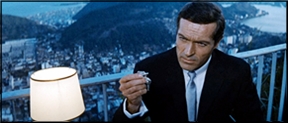
OSS 117: MISSION FOR A KILLER. Valoria Films, France/Italy, 1965. Embassy Pictures, US, 1966. Originally released as Furia à Bahia pour OSS 117. Frederick Stafford (Hubert Bonnisseur de la Bath, alias OSS 117), Mylene Demeonget, Raymond Pellegrin. Based on the novel Dernier quart d’heure by Jean Bruce, his 44th OSS 117 book, published in English in 1965 under the title Live Wire (UK) and The Last Quarter Hour (USA). Directed by Arthur Hunnebelle.
This third outing in the series of OSS 117 films in the Sixies features Frederick Stafford (Topaz, 1969) as Hubert Bonisoir de la Bath, OSS 117, the American CIA agent created by popular French journalist and former Resistance fighter and FFI agent Jean Bruce.
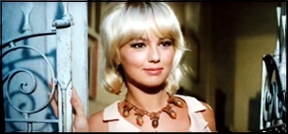
Unlike most of the briefly popular Eurospy genre that followed in the wake of the James Bond craze, the OSS 117 films were mostly expensive productions in the Bond mode, this one filmed on location in Brazil and with some sets and big action scenes rivaling a James Bond film of the era.
Hubert (Frederick Stafford) has been called off his vacation because of a series of terrorists acts in South America. A journalist in Rio de Janero has information leading to a mysterious group that is using some unknown drug to turn innocents into deadly killers, and it is the job of OSS 117 to contact him and follow the clues to the plans of these dangerous assassins.
The usual beautiful women and dangerous games follow, handsomely shot in Eastmancolor with fine cinematography in Francoscope, the French equivalent of Cinemascope and thanks to the Bruce novel, the story is loosely based on a more cogent plot than most Eurospy films could manage. The budgets and production values far exceed the George Nader / Jerry Cotton films or the Joe Walker / Kommisar X films, much less the various films starring Roger Hanin, Ken Clark, German Cobos, Ray Danton, Gordon Scott, Brett Halsey, or Anthony Eisley to name a few.
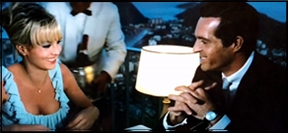
Stafford, who was wooden in Alfred Hitchcock’s Topaz, is relaxed and playful in his first outing as Bruce’s dashing agent who had previously been played in two films with Kerwin Matthews and would be played one more time by Stafford before a final outing with John Gavin in the role.
Of course when OSS 117 reemerged in the 21rst Century it would be in the person of Jean Dujardin in two brilliant spy comedies that recreated the look and feel of the original films, but with Hubert something of a sexist dunce whose 1950’s early 1960’s Playboy lifestyle sensibility is clashing with a changing world. In addition the two Dujardin films turned Hubert into a French spy, rather than the Louisiana-born Creole aristocrat CIA agent of the books.
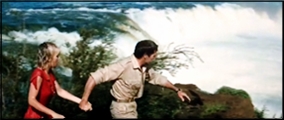
Aside from the novels by Jean Bruce, OSS 117 was successful in comics and other mediums in his long run though the books never did well here (two were published by Fawcett Crest in the Sixties). There were more published in England, but still Hubert never saw anything like the same success in English as he had on the Continent.
It should be pointed out that however much this series of films was influenced by the success of the Bond films, OSS 117 himself was created in 1948, and had a five year run before 007 made his debut in Casino Royale in 1953. In addition the first OSS 117 movie appeared in 1957 well before Dr. No in 1962.
Desmond Cory’s Johnny Fedora also beat Ian Fleming and Bond into print by five years, as did several other post war spies including Burke Wilkinson’s Geoffrey Mildmay (Proceed at Will, Run Mongoose) and Sea Lion’s Desmond Drake (Damn Desmond Drake), the influence for all for all but Wilkinson being Peter Cheyney’s well received “Dark” series of spy novels written during the war and even praised by Anthony Boucher, who wrote the introduction to the omnibus edition of the books.

It was simply an idea whose time had come and Fleming was best positioned with a mix of style, panache, war time experience, and luck to cash in. He was of course a better writer than all but Cory (Shaun McCarthy), and a more serious one than him, plus Fleming kept an eye out for the American market from the start even if it took time to crack it.
The parallels between Fleming and Bruce are still notable both in the numeric identification of their heroes, their war time intelligence ties, both men being journalists, their legendary drinking and womanizing, and both dying in 1964 at relatively young ages (Fleming of a heart attack, Bruce in a wreck in his beloved sports car). And like Bond, Bruce’s creation lived on as a sort of family cottage industry.
Arthur Hunnebelle (Fantomas) directed this one which finds Hubert teaming with beautiful Mylene Demeonget and hostage of a supervillain who plans nothing less than taking over all of South America by assassinating the current leaders and creating a new super power and world order dedicated to harmony and peace, and if murder and torture are what it takes to achieve that end,..
Eggs cracked and all that.
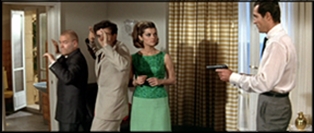
The finale is a battle with Hubert and a handful of allies and natives who the madman has enslaved and experimented on shooting it out in a jungle mountain fortress before the arrival of the Brazillian army by parachute (in a scene mindful of the similar arrival of the cavalry in Thunderball) and a final confrontation between the fleeing villain and Hubert over a vast waterfall as he rescues Demeonget.
It’s all nonsense, but by the standards of the Eurospy genre as spectacular as the then contemporary Bond films if lacking some of the narrative drive and those pulsing John Barry scores — and of course, Sean Connery.
The five Sixties films are worth seeing still (available in a boxed set on DVD), and by all means the wonderful Jean Dujardin films, OSS 117: Cairo Nest of Spies, and OSS 11:7 Lost in Rio (DVD and Blue Ray). The 1957 film is available in French on YouTube, OSS 117 is not Dead with Ivan Desny. A couple of other non-OSS 117 Jean Bruce books into films are also out there and available on YouTube including Mission to Venice with Sean Flynn and ex-OSS 117 star Kerwin Matthews as The Viscount, a suave insurance investigator.
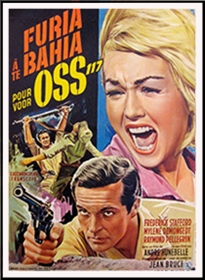
Filmography:
OSS 117 is not Dead (1957) Ivan Desny (B&W)
OSS 117 is Unleashed (1963) Kerwin Matthews (B&W)
OSS 117 Panic in Bangkok (1964) Kerwin Matthews
OSS 117 Mission for a Killer (1965) Frederick Stafford
OSS 117 Mission to Tokyo (1966) Frederick Stafford
OSS 117 Double Agent (1968) John Gavin
OSS 117 Cairo Nest of Spies (2006) Jean Dujardin
OSS 117 Lost in Rio (2009) Jean Dujardin
Thu 21 Jan 2021
PATRICIA CORNWELL – From Potter’s Field. Kay Scarpetta #6. Scribner, hardcover, 1995. Berkley, paperback, 1996.
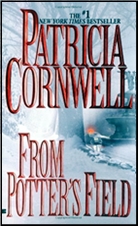
Cornwell is an author whose books I’ve enjoyed somewhat, but judging by her sales, not to anywhere near the extent that others have. A strong female protagonist, serial killer, and big, thick books seem to make a formula for the 80s and 90s. I guess it’d be fair to say that I think her a bit overrated.
Kay Scarpetta is chief medical examiner for the State of Virginia now, and a consultant to the FBI. As the story opens, her “routine†duties are interrupted by news of a killing in New York that is suspected to be the work of a serial killer who has eluded capture for several years now. Kay is off to New York on the next plane with her Richmond police friend who also assists on serial killer cases and the FBI agent who is also her lover. The killing is indeed the work of their quarry, and as he escalates his activities it becomes apparent that Kay herself is in some way an object of his perverse affections. Who the hunter and who the hunted, indeed.
Cornwell is a quite competent writer in terms of prose and pacing, but her prose is straightforward and not remarkable, and pacing only becomes a conscious factor when it’s lacking or faulty. Books like this stand or fall on how much you can become involved with the characters, and how much the subject matter appeals to you. Serial killers don’t, to me; my interest in psychopaths is limited. There’s little real suspense in such books, only “thrills” which don’t. Nor do I find Kay Scarpetta or many of the other characters Cornwell creates particularly appealing or interesting. Too, having a personage of Scarpetta’ s rank end up mano a mano with the killer may be de rigueur for books of this nature, but it’s still silly. My affections for Patsy and Kay remain lukewarm, I’m afraid.
Thu 21 Jan 2021
NEVER LET GO. Rank Film Distributors Ltd., UK, 1960. Richard Todd, Peter Sellers, Elizabeth Sellars, Adam Faith, Carol White, Mervyn Johns. Co-screenwriter/director: John Guillermin. Currently available on YouTube here.
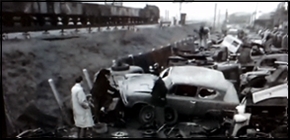
You’d hardly believe it was Peter Sellers. Well, that’s not quite true. It’s just that one doesn’t necessarily think of Sellers when one thinks of a cinematic villain. Indeed, Sellers almost never played completely straight roles, let alone villainous ones. That, above all else, is what makes Never Let Go worth watching. For here one gets to see how much of a range Sellers had and how incredibly captivating a performance he was capable of when presented with the opportunity.
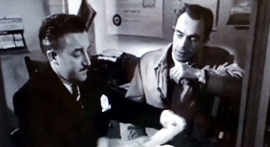
Directed by John Guillerman, this late British noir exudes a somewhat sleazy, definitively downmarket atmosphere boosted by a jazzy John Barry score. This is not posh London, but the London of juvenile delinquents and the lower middle class struggling to get by. Among them is perfume salesman John Cummings (Richard Todd), a perpetual dreamer who thinks success is just over the horizon. When his recently purchased 1959 Ford Anglia is stolen, he sets out on a frenzied quest – think Moby Dick – to get his beloved car back.
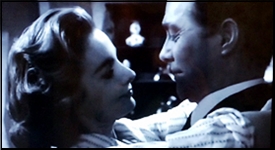
This puts him at odds with both the police and the leader of a vehicular theft ring by the name of Lionel Meadows (Peter Sellers). Meadows is a brute of a man. Cruel and vindictive, he isn’t above hitting women, killing animals (note: there is a particularly disturbing scene where a real fish is left flopping on the ground), and forcing a lonely, elderly man into taking his own life.
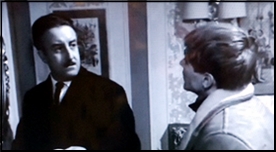
As much as Meadows is cruel, Cummings is determined. He will get his car back, even if it costs him his marriage or his life. This obsessive desire can be best understood as reflective of the perilous economic status of England’s middle class. It’s not so much the car that he wants, as it is what the car represents; namely, the post-war dream for societal and economic advancement in a rigidly stratified society.
Even though Cummings is the titular hero in his psychodrama, it is Meadows who is the most memorable character. Richard Todd simply can’t compete with Peter Sellers in holding the audience’s attention. It’s a downright chilling performance from a legendary actor most associated with his comedic roles.

Thu 21 Jan 2021
ROBERT LOPRESTI “The Charity Case.†Marty Crow #9?? Black Cat Mystery Magazine #7, paperback, November 2020 (Special Private Eye Edition).
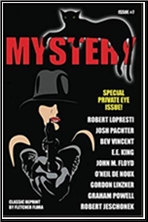
Private eye Marty Crow’s home base is Atlantic City, and if this fairly recent example is at all representative, even though that particular town must have its dark and dangerous streets, his adventures are not to be taken all that seriously. In “The Charity Case†he’s hired by a couple visiting from some prairie state who claim they’ve been robbed of $800 by a beggar on the street.
But when Crow talks to the husband alone, the latter admits that he simply gave the man the money. It seems that he’s a member of the Final Days Punctionalist Church, and they believe devoutly in helping outsiders and people down on their luck. There is about to be a schism in the church, however, a religious issue, concerning to whom charity should be given. And if Crow doesn’t get the money back, a marriage is likely to break up as well.
But what about the bum he gave the money to? Ah, that’s where the story lies. Neither Sam Spade nor Philip Marlowe would be caught in a story such as this, but the world of PI fiction is a whole lot larger than what they could ever have imagined. This story proves it.
Earlier stories in the series include:
Thanks to the Thrilling Detective website for the list of stories above.
Added later, taken from Robert Lopreski’s website:
Wed 20 Jan 2021
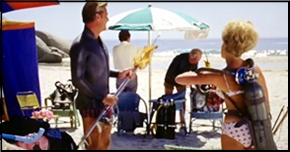
CODE 7: VICTIM 5. British Lion Film Corp., UK, 1964. Columbia Pictures, US, 1965. Lex Barker, Ann Smyrner, Ronald Fraser, Walter Rilla. Co-producer (uncredited): Harry Alan Towers. Director: Robert Lynn.
Code 7: Victim 5 has the distinction (?) of being one of the first films to try and cash in on the post-Goldfinger James Bond craze. This was marketed as a spy thriller (The original title was simply Victim 5) but it’s actually … well, what is it exactly? Something about a New York Private Eye named Steve Martin (is he meant to be the same character Raymond Burr played in Godzilla? Could this be the basis of future academic discussion?) called to Cape Town South Africa to find out who killed a millionaire’s butler, and learning this is simply one in a series of murders involving former POWs from World War II who … who … zzzzz.
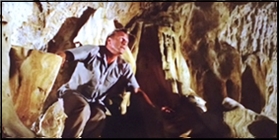
Steve (played here by Lex Barker) Martin’s investigative technique consists of going from one tourist spot to another – any place where there’s scenery, really — looking for clues or something and getting in fights, shoot-outs and car chases, all of which, the background music Insists, must be very exciting, but they seemed sort of blah to me.
There’s a bit of imagination In one sequence involving Death by Ostrich Stampede, and late in the film we get to see the former Tarzan once again stalking lions through the jungle, but mostly this is the kind of film that is usually (and charitably) dismissed as “routine.” The smutty-sub-Bond double-entendres and the plethora of girls In Beach Party bikinis, sporting 1960s hairdo’s maybe made the movie look hip back in ’65, but now it just looks quaint — it doesn’t have a quaint charm, it’s merely quaint.
Tue 19 Jan 2021
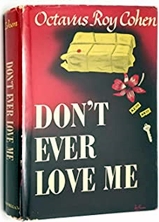
OCTAVUS ROY COHEN – Don’t Ever Love Me. Macmillan, hardcover, 1946. Popular Library #332, paperback, 1951.
Octavus Roy Cohen’s mysteries are slick and entertaining, smoothly written in a style that no doubt appealed to the readers of the Saturday Evening Post and other publications where many of his stories. appeared. Don’t Ever Love Me is a good example of his novel-length work, a light romantic mystery featuring a fairly liberated heroine, at least by the standards of 1946.
Lynn Sheridan, a successful copywriter for a New York advertising firm, is the victim of what seems to be a series of bizarre practical jokes: Someone calls the police to report her murder: someone calls an ambulance service to report that she has been badly hurt; and her escort to the opera is killed by a bullet that passes so close to her that she can hear it buzz by. Naturally all this puts quite a strain on Lynn and her fiancé, Alan Gordon.

To say much more about the plot would be unfair, but it involves two more murders and a goodly number of suspects. Cohen manages some adroit misdirection before Gordon, to the astonishment of the homicide detective on the case, manages to figure out just exactly what has been going on. And of course, it’s fun to consider the detective’s final words on the case in light of today’s methods of law enforcement: “The confession is what counts – not how you get it.”
Paperback collectors will find the cover of the 1951 Popular Library edition of Don’t Ever Love Me irresistible, even though the beautiful blonde with the dark eyebrows and the automatic pistol has nothing at all to do with the story.
Jim Hanvey, Detective ( 1923) is a collection of short stories that demonstrates Cohen’s ability in that form. And Cohen came up with the title Scrambled Yeggs (1934) years before Richard S. Prather.
———
Reprinted with permission from 1001 Midnights, edited by Bill Pronzini & Marcia Muller and published by The Battered Silicon Dispatch Box, 2007. Copyright © 1986, 2007 by the Pronzini-Muller Family Trust.
Tue 19 Jan 2021
ELLERY QUEEN’S MYSTERY MAGAZINE, December 1966. Overall rating: 3 stars.
JACOB HAY “The Opposite Number.†The “inside†story of the spy business. (3)
AGATHA CHRISTIE “Hercule Poirot and the Sixth Chair.†Original title: “Yellow Iris.†Poirot stops a murder from occurring at a dinner party. (3)
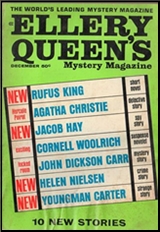
WILLIAM BRITTAIN “The Boy Who Read Agatha Christie.†Schoolboy foils plan of college students. Enjoyable but trivial. (3)
ARTHUR PORGES “Private Beachhead.†Gimmick with radios too uncertain for story basis. (2)
YOUNGMAN CARTER “Seeds of Time.†SF story about visitor through time. Nothing unusual. (3)
CORNELL WOOLRICH “All It Takes Is Brains.†Novelette. Original title “Crime of St. Catherine Street.†Man on a bet enters Montreal with 75¢ and leaves with $1500, being wanted for murder in the meantime. Exciting in pulp style. (4)
CHRISTOPHER ANVIL “The Problem Solver and the Defector.†Verner finds secret plans. (3)
GEORGE EMMETT “Pushkin Pays.†Attempt to dispose of body in ocean fails, thanks to appearance of Russian submarine. (1)
HELEN NIELSEN “The Chicken Feed Mine.†Three ex-servicemen kill a desert rat for his “savings.†(3)
JOHN T. SLADEK “Capital C on Planet Amp.†SF, but in far-out camp style. Garbage. (0)
L. E. BEHNEY “The Long Hot Day.†Tale from home. Husband kills stranger his wife falsely accuses. (3)
JOHN DICKSON CARR “To Wake the Dead.†Original title “Blind Man’s Hood.†An adequate locked room mystery, but supernatural tone of story is forced. (2)
RUFUS KING “Anatomy of a Crime.†hort novel. Stuff Drscoll solves a murder made to appear a textbook suicide. Actually an inverted detective story as the reader follows the battle of wits between murderer and investigator with fascination. (4)
Mon 18 Jan 2021
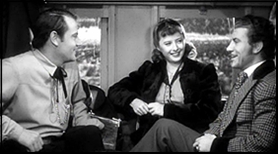
UNION PACIFIC. Paramount Pictures, 1939. Barbara Stanwyck, Joel McCrea, Robert Preston, Brian Donlevy, Akim Tamiroff, Lynne Overman, Robert Barrat, Henry Kolker, Anthony Quinn, Lon Chaney Jr., Stanley Ridges, Evelyn Keyes, Regis Toomey, Joe Sawyer, J. M. Kerrigan, Richard Lane, Fuzzy Knight. Screenplay by Walter DeLeon, C. Gardner Sullivan, and Jessie Lasky Jr.; adapted by Jack Cunningham from a story Ernest Haycox (also uncredited on the screenplay, along with Frederick Hazlitt Brennan). Directed by Cecil B. DeMille.
One of Cecil B. DeMille’s better epics, and probably his best Western, the story of the race to Ogden, Utah, by the Central Pacific and Union Pacific Railroad centers on the efforts of trouble-shooter Jeff Butler (Joel McCrea) in the employee of General Dodge (Francis McDonald) to prevent murderous gambler Syd Campeau (Brian Donlevy) from sabotaging the advance of the title railroad for crooked Chicago businessman A. M. Barrows (Henry Kolker), who plans to fund the Union Pacific, buy Central Pacific stock and make a fortune selling the former short when it fails by his machinations.
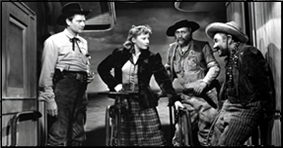
It’s based on a tight well written story by Ernest Haycox, ironically whose story “The Last Stage to Lordsburg†was filmed as Stagecoach the same year. Cecil B.DeMille and John Ford both using your work as a source the same year was a pretty heady place for a pulpster to be, and it showed when Haycox, already in the slick, soon graduated to the Book Club circuit and best seller list too.
Complicating things is the three-way romance between Irish postmistress Molly Monahan (Barbara Stanwyck, beautiful, though you can take some issue with her Irish accent), daughter of engineer Monahan (J. M. Kerrigan) who drives the General McPherson, charming rogue Dick Allen (Robert Preston), Butler’s former wartime friend and Campeau’s partner, and Jeff.
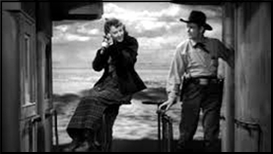
As usual the history in any DeMille epic is only there to back up a good deal of myth and legend and a certain amount of flag-waving and or Bible-thumping, but it is pretty good corn here with lots of riding, shooting (a memorable shootout between McCrea and Anthony Quinn, “It’s a good thing you keep that mirror clean.â€), fighting (a good fight between McCrea and Robert Barratt), and romance between Stanwyck and charming Preston and reticent stalwart McCrea (“I loved him from the first time I hit him.â€).
When Allen steals the railroad payroll Molly covers for him, but forces him to return the loot in exchange for marrying him which puts him on the wrong side of Campeau.
Akim Tamiroff is Fiesta and Lynne Overman, Leach Overmile, Butler’s seedy comedic companions. They were similarly teamed, only on opposite sides, in Northwest Mounted Police. Preston played similar rogues in the former and in Reap the Wild Wind (also with Overman). Virtually everyone in the film from son-in-law Quinn to the least bit part is from a DeMille regular (Monte Blue, Elmo Lincoln, Frank Lacteen, and Iron Eyes Cody all are uncredited and look for a young Richard Denning).
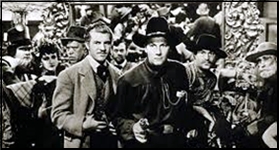
There is an old saw about the basic kinds of Western, and this one fits clearly in the Empire building category of silent classics like The Iron Horse and Covered Wagon. It’s a bit old fashioned even for 1939, considering it competes with Stagecoach.
Molly marries Dick to save Jeff, but Campeau talks and Jeff arrests him the day of their wedding. She helps him escape, but when Dick hides out on Molly’s car on the way to Laramie he discovers she really loves Jeff just before they are attacked by a Sioux war party stirred up by Campeau.
However you view the whitewashing of Western history or the exploitation of Native Americans it is a splendid sequence visually with DeMille at his best right down to the cavalry coming on another train.
There is some sympathy for Native Americans expressed here, more than in Stagecoach where Ford uses them only as a force of nature.
That rescue train crossing a burning trestle is beautifully shot, right down to the comic relief when Tamiroff’s mustache is burned off (Overman: “I never liked it in the first place.â€)
There are a number of scenes like that in the film including Irish track layer Regis Toomey murdered by Anthony Quinn speaking of the light as a shadow passes over his dying face and a weeping Stanwyck holds him in her arms on the saloon floor.
Another nice set piece features Jeff and Monahan pushing the General MacPherson across a snow bridge to cut around a tunnel they can’t complete in time. “’Tis the first time for an engine to run on snow, and if he don’t like it, I’ll put snowshoes on him.â€

Yes, it is corny, right down to the use of “My Darlin’ Clementine†as a running theme throughout the film even as a funeral dirge for Monahan when the first attempt at crossing the snow proves fatal, but it still has cinematic power in the old Hollywood tradition. It may be model work, and obvious to us today, but it was state of the art in 1939.
Finally at Promontory Point Jeff, Molly, and Dick are reunited as the golden spike is driven in with Campeau planning revenge.
Jeff: He’ll be waiting for us Molly — at the end of track.
Just before the vintage railroad becomes a gleaming modern engine cutting across America as the music swells.
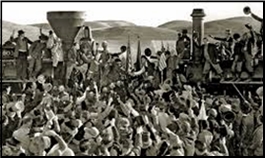
I’ll grant some of you have grown too sophisticated for this to work, some will find a million reasons to find offense at something or other, and I don’t fault you if you do, but even recognizing its flaws, it is splendid film making, a classic Hollywood cast and creative talents working at the top of their form, and Western mythologizing in the epic mode at its best. I still think there is something to be said for the lost arts that made it possible that is worth recognizing and applauding whatever the social flaws or the lack of modern sophistication.
I hope I never reach the point I can’t still respond to this kind of film a little like the kid lying on the living room floor looking up at a twenty-seven inch black and white screen, eating popcorn, and watching this unfold between commercials. I hope every one of you still has some films that bring back something like that for you.
There was a reason Hollywood was called the Dream Factory.

Mon 18 Jan 2021
JANE ADAMS – The Greenway. Det. Inspector Mike Croft #1. Macmillan, UK, hardcover, 1995. Fawcett Gold Medal, US, paperback, 1997. Setting: Contemporary England.
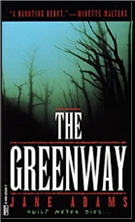
Cassie Maltham’s cousin disappeared while they were taking a short-cut home through the Greenway, an ancient passageway in Norfolk. Cassie couldn’t remember what had happened, but has suffered from depression and nightmares ever since. Now, 20 years later, Cassie has returned to Norfolk trying to let go of the past. But when another young girl disappears, it draws Cassie back into her nightmares. Detective Inspector Mike Croft, through the urging of Sergeant Bill Enfield, elicits the help of John Tynan, the retired detective who investigated the disappearance of Cassie’s cousin.
Ms. Adams has written a haunting, yet very human book about guilt and loss. Cassie suffers survivor’s guilt; why did her cousin disappear rather than she. Croft knows the anguish of losing a child, although his son had been killed in a hit-and-run. The story was absorbing with good twists along the way and touches of the supernatural. I shall definitely read more of Ms. Adams’ work.
Rating: Good Plus
The Det. Inspector Mike Croft series –
1. The Greenway (1995)
2. Cast the First Stone (1996) aka The Secrets
3. Fade to Grey (1998) aka Their Final Moments / Final Frame
4. The Liar (2019)